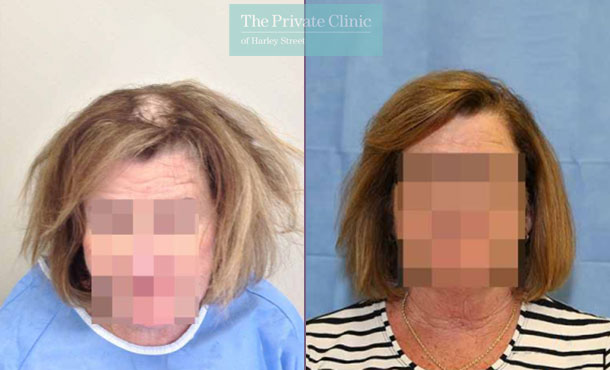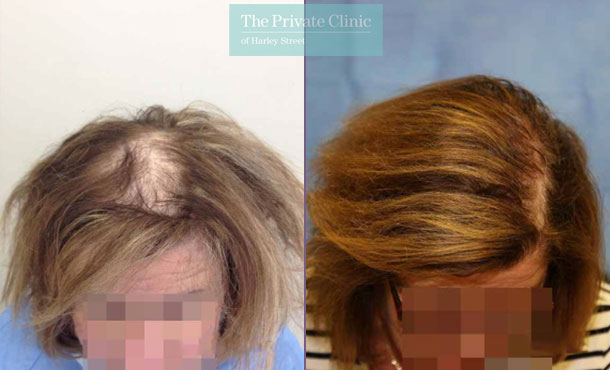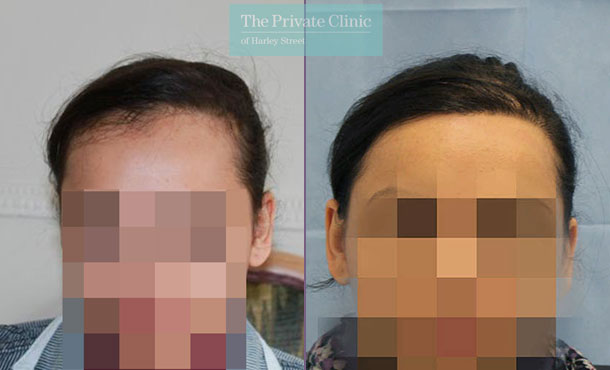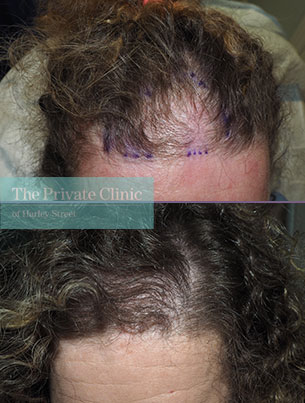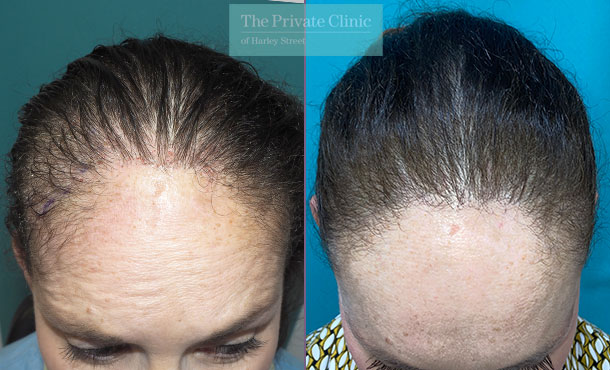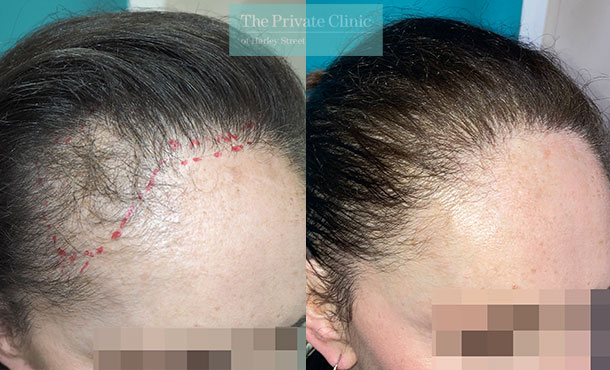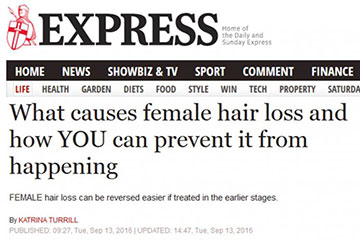
- Female hair transplants are a specialised hair restoration procedure
- 1 in 4 women will experience hair thinning in their lifetime
- Expert Hair Transplant surgeons who specalise in Female cases
What’s on this page
- About this Treatment
- Before & After Photos
- What to Expect
- Female hair transplant FAQs
- Our Clinics
- Meet the Surgeons
- Related Blogs & News
Medically reviewed by Lorcan Sheppard BSc MBBS FRCA, Chief Medical Officer for The Private Clinic of Harley Street, London.
Last Reviewed April 2nd 2025
Related Treatments
Female Hair Transplant
Whilst hair transplant procedures are more commonly performed on men, it is possible for women to have a hair transplant procedure too and this is steadily increasing in popularity.
Hair loss is a sensitive topic and losing hair can decrease confidence as well as have a negative impact on a person’s mental health.
It is reported that one in three women will experience hair loss during their life. The cause of female hair loss is a lot wider and could be down to a number of factors including:
- Menopause
- Pregnancy
- Medication
- Over styling
- Female Pattern Baldness
Female pattern baldness, also known as Androgenetic alopecia in women, can be classified using the Ludwig classification system. Although female pattern baldness is not treatable, there are a variety of treatments available that can help to slow and restore hair loss. Find out more about Hair Loss treatments here.
In most cases, female hair loss is not permanent, and many patients expect to see their hair grow back over time with lifestyle changes, medication, and non-surgical hair loss treatments.
In some cases, it may be suggested that the best way of resolving your hair loss issues is to undergo a hair transplant procedure to restore areas of hair loss.
A female hair transplant procedure should only be performed once the cause of hair loss has been established. This often requires the patient to have a consultation with a hair loss expert prior to a hair transplant surgeon who will be able to identify the source of hair loss and advise as to whether or not restoration surgery is a good option and is likely to be successful.
Hair transplantation for women
Female hair transplants are a specialised hair restoration procedure and should only be undertaken by a hair transplant surgeon who is knowledgeable and skilled in female hair transplant procedures.
Depending on the cause of hair loss, the areas which need to be treated in a female hair transplant will vary whereas some may need a hair transplant that focuses on restoring the hairline and temples, and others may need a more widespread treatment to improve on hair thinning.
At The Private Clinic, our surgeons are experts in female hair transplant procedures. We offer women an option of unshaven, partially shaven, and fully shaven FUE hair transplant procedures where possible.
Your treatment always needs to be unique to you. We don’t believe in blanket methods or quick-fixes; our team are there to find the cause of your hair loss and ensure – if treatment goes ahead – it is the best way for your needs.
Ask us a question
Female Hair Transplant Before & After Photos
Take a look at the Before and After photos to see how we have helped change our patients’ lives.
What to Expect
The Consultation
Before undergoing any form of treatment, you may be advised to have a consultation with one of our hair loss experts. They will work with you to be able to identify the source of hair loss and advise as to whether or not restoration surgery is a good option and is likely to be successful.
If a hair transplant has been agreed upon as a viable option, you will have a consultation with one of our expert hair transplant surgeons.
During a hair transplant consultation, our surgeons will:
- Listen to your hair loss concerns
- Review your medical history
- Analyse your hair and scalp
- Discuss which procedure would be most suited
- Provide you with recovery and aftercare information
- Go through the risks and complications
If you are deemed to be suitable for a hair transplant procedure you will be presented with a personalised treatment plan and quote. This will allow you to make a fully informed decision. You will also be allocated a patient coordinator who is your point of contact should you have any further questions, wish to make another consultation appointment or if you wish to book surgery.
Click here to find out more about what to expect in a hair transplant consultation.

The Procedure
We have some of the most experienced Hair Transplant Surgeons in Europe able to offer the most advanced method of minimally invasive hair restoration – FUE (Follicular Unit Extraction).
Hair Transplants are performed in-clinic in one of our state-of-the-art theatres. The walk-in, walk-out method requires no hospital stay and leaves no linear scarring. The procedure can take 6-8 hours to perform, or in some cases may be performed as a 2-day procedure. The time allowed for your hair transplant procedure will be discussed in your consultation
Female Hair Transplant Procedure:
- You will be prepped for your hair transplant procedure, shaving of the head may be required which will be carried out in the most sensitive manner ensuring that it is not noticeable.
- You will then lay face down on the treatment bed and local anaesthetic and tumescent injections will be administered to the scalp.
- Once the local anaesthetic has taken effect, the treatment will begin with the surgeon extracting hair follicles from the donor area using a specialised punch device for minimal trauma.
- As the hair grafts are extracted, they will be placed in trays where they will be grouped into single, two, and three or more hair graft categories and recorded.
- There will usually be a break for lunch once the extraction process has taken place.
- You will then lay face up on the treatment bed so the surgeon can access all the areas that are to be treated.
- Local anaesthetic and tumescent will be administered into these areas
- The hair grafts are then implanted into the areas being treated under a microscope to ensure that they match the natural direction of hair growth.
- Once the procedure is finished, the patient will be shown the results before they have bandages applied.
Your surgeon will then go through the aftercare plan and recovery process providing you with an aftercare kit to take home.
Once the clinic team are happy that you are feeling well and safe to return home, will discharge you from the clinic with your chaperone.

Aftercare & Results
The day following your procedure, you will be contacted by a member of our nursing team to ensure you are feeling comfortable and recovering well following your hair transplant procedure.
Should you feel the need to contact us, you will have the details of our on-call nursing team who can be contacted 24/7 should you have any worries or concerns at any point during your recovery.
Swelling, redness and tightness are all common in the initial days following an FUE Hair Transplant. This can take a few days to subside but the medication provided should help you to feel comfortable.
A strict aftercare plan will have been provided to you by your surgeon which involves spraying the scalp with a saline solution on a regular basis for the first couple of days following your procedure. It is really important that you follow this plan in order to ensure the best results.
Post-operative appointments usually take place at 6 weeks and 12 months where your surgeon will then be able to advise further on how to look after your newly implanted follicles
We recommend that patients take at least 1-3 days off work depending on the nature of your role but for patients who wish to be more secretive of their hair transplant procedure may be worth booking at least 1 week or longer off work to allow for the area to heal and any redness to subside.
Exercise and strenuous activity should be avoided for 2 weeks.
The full recovery time of an FUE Hair Transplant procedure is around 6 weeks but your final results can take up to 12 months to fully be seen.
Click here to find out more about FUE Hair Transplant aftercare.

The Private Clinic have collaborated with Chrysalis Finance to offer 0% finance for our patients.*
*Acceptance is subject to status. Terms and conditions apply.
Frequently Asked Questions
In order to explain the benefits of our treatment and what it involves, it helps to give you an idea of what is involved in the more invasive Strip technique.
The Strip technique involves removing a long band of skin from the back of the head with a scalpel, then dissecting the follicles under a microscope before placing them onto the bald or thinning area. This technique always leaves a scar, no matter how skilled the surgeon is, and can cause nerve damage and numbness of the scalp.
With FUE, a special punch less than 1 mm in diameter is used to remove the hair follicles directly from the scalp. There is no need for a scalpel, hence no stitching or scarring. We can safely extract up to 7000 hairs in one day whereas with previous generations of FUE it was only possible to safely extract 2500 hairs a day. Another advantage of FUE is that none of the follicular units are damaged during the extraction, whereas with the Strip method up to 30% of the donor follicles may be damaged by the use of a scalpel.
Female Hair Transplants are performed under a local anaesthetic so you might feel a small prick initially whilst this is being administered. But, once it takes affect, you should not feel any pain for the rest of the hair transplant operation.
In the days following a hair transplant procedure you may feel a bit sore in the areas treated but this should only be temporary and you will be provided with medication to help you feel more comfortable.
The length of the treatment depends on the number of hairs needed.
Most female hair transplant procedures usually take between 6 and 8 hours.
In larger cases, the procedure may be split across 2 days. In smaller cases, it will take less time.
You will be provided with an estimated time following your consultation.
Female Hair Transplant procedures will be different depending on each patients needs. It is important to understand that costing for a hair transplant is very individual and will depend on a number of factors which can only be assessed during a female hair transplant consultation.
On average we price by the number of hairs you will require and charge approximately £2.50 per hair for standard FUE Hair Transplant procedures.
We are not the cheapest nor the most expensive, but we believe to be amongst some of the best hair transplant clinics and surgeons in the UK.
We are also regulated by the Care Quality Commission (CQC) and have been established for over 40 years meaning you can be sure we will still be here – to help and advise – long after your surgery.
Female Hair Transplants and Hair Loss Treatment is Available in these Clinics
Meet our Medical Staff
Our team of fully-qualified hair loss experts can help diagnose underlying hair problems and our team of expert Hair Transplant Surgeons will provide advice and surgical or non-surgical treatment options.
Consultant Plastic Surgeon, Hair Transplant Surgeon & Vaser Lipo Total Definer Surgeon





